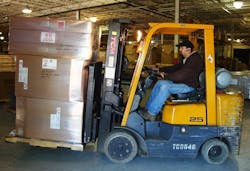Electronic Logging Devices (ELDs) have focused more attention on the problem of delays at shipper and receiver locations. Not only do these delays eat into the drivers’ Hours of Service (HOS), they sidetrack shipments and add inefficiency to the supply chain.
Keeping freight moving is the job of everyone in the supply chain. Fleets have to make sure their trucks are in good operating condition. Dispatch has to monitor drivers’ hours. Operations must optimize routing. But shippers and receivers have responsibilities too. I can't think of a good reason why a driver should be sitting at a dock for upwards of two hours waiting to load or unload. How frustrating?
It’s hard to blame drivers for idling during these long periods with nothing to do. And as we all know idling wastes fuel. But whenever a driver and a truck end up sitting productivity suffers.
It is bad enough that drivers must deal with bottlenecks on the roadways when they are driving. The American Transportation Research Institute recently came out with its list of 2019 Top Truck Bottlenecks. Rich McArdle, president of UPS was quoted in an ATRI release announcing the report findings as saying, “For UPS, if all of our vehicles are delayed just five minutes a day, every day, it costs our company $114 million a year.”
And that is just for one fleet with a five-minute delay. Think of how big that number would be if trucks had to sit at docks or at customer yards for hours at a time.
Whether from congestion or waits to load and unload, delays are making us inefficient.
I’ve challenged drivers, fleets and manufacturers to do what they can to improve fuel economy. Now I am challenging shippers and receivers to look at their operations to see where you can make changes. Are you supplying carriers with realistic pickup and delivery windows? Are you using technology to provide visibility into the entire shipping process so you can identify where delays are occurring and then take steps to eliminate them?
Freight efficiency isn’t just about using less fuel. It is also about making sure that things move from point A to point B on trucks with wheels turning not sitting still.
About the Author

Michael Roeth
Executive Director
Michael Roeth is the executive director of the North American Council for Freight Efficiency. He serves on the second National Academy of Sciences Committee on Technologies and Approaches for Reducing the Fuel Consumption of Medium and Heavy-Duty Vehicles and has held various positions with Navistar and Behr/Cummins.
